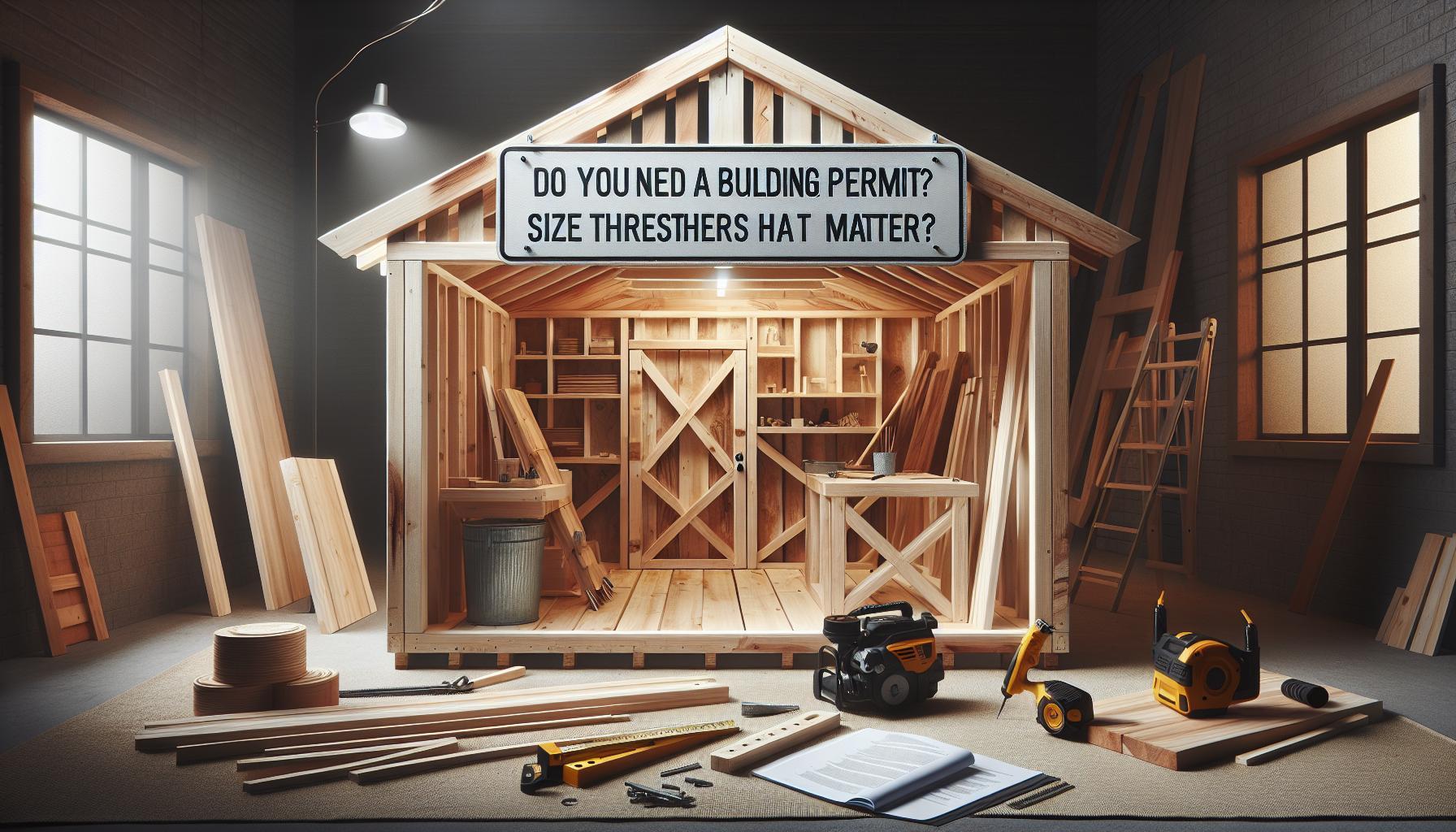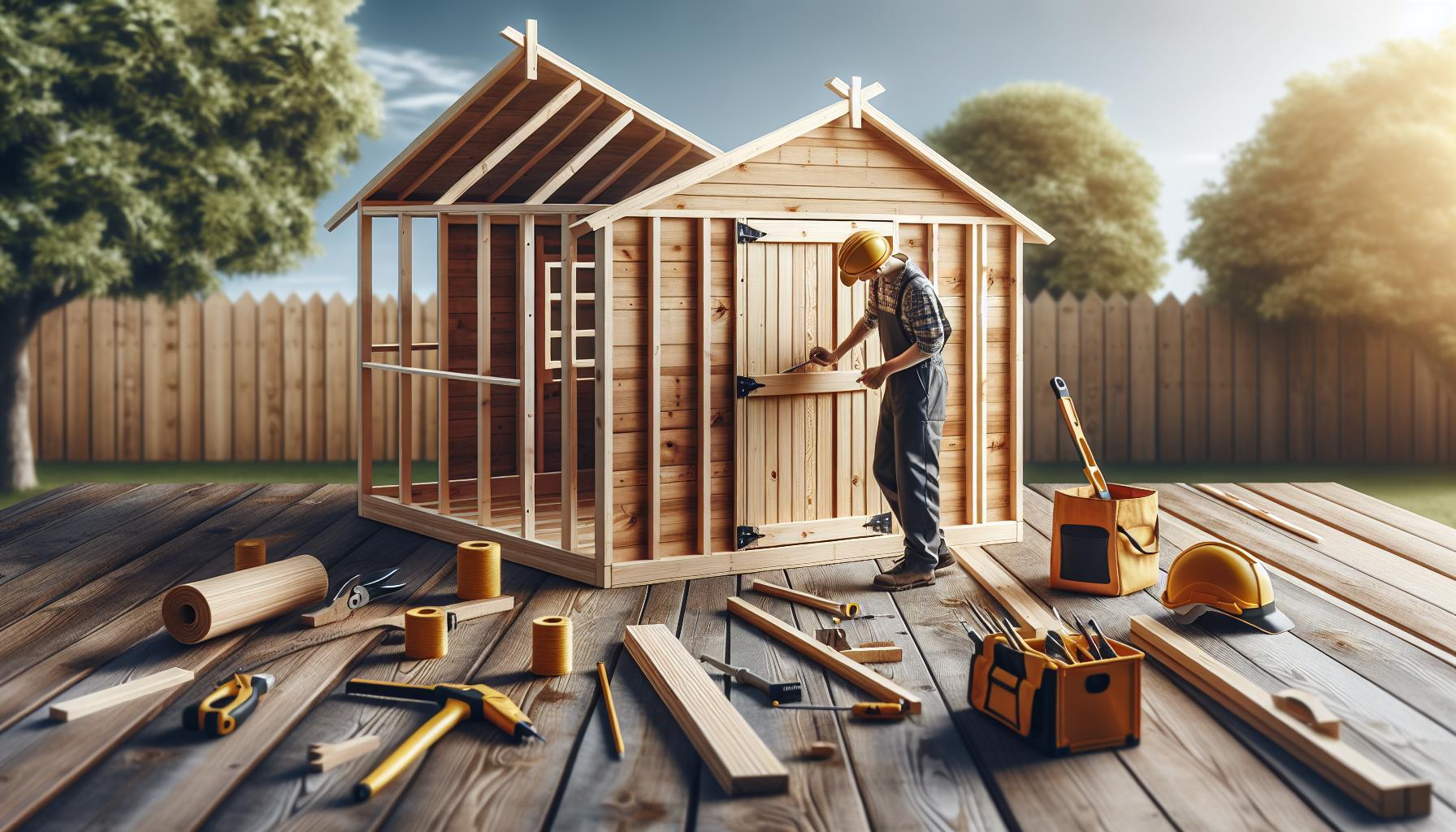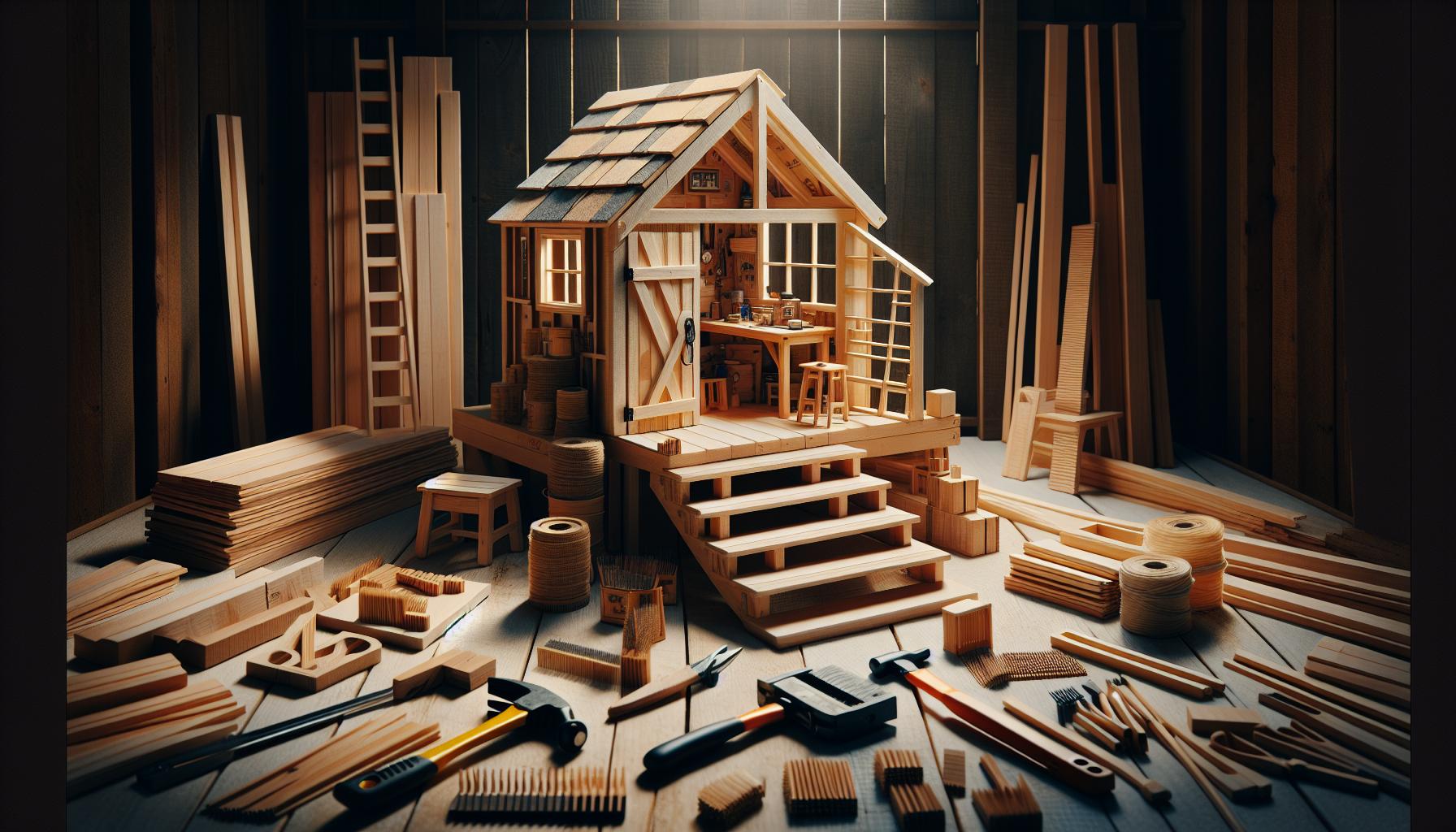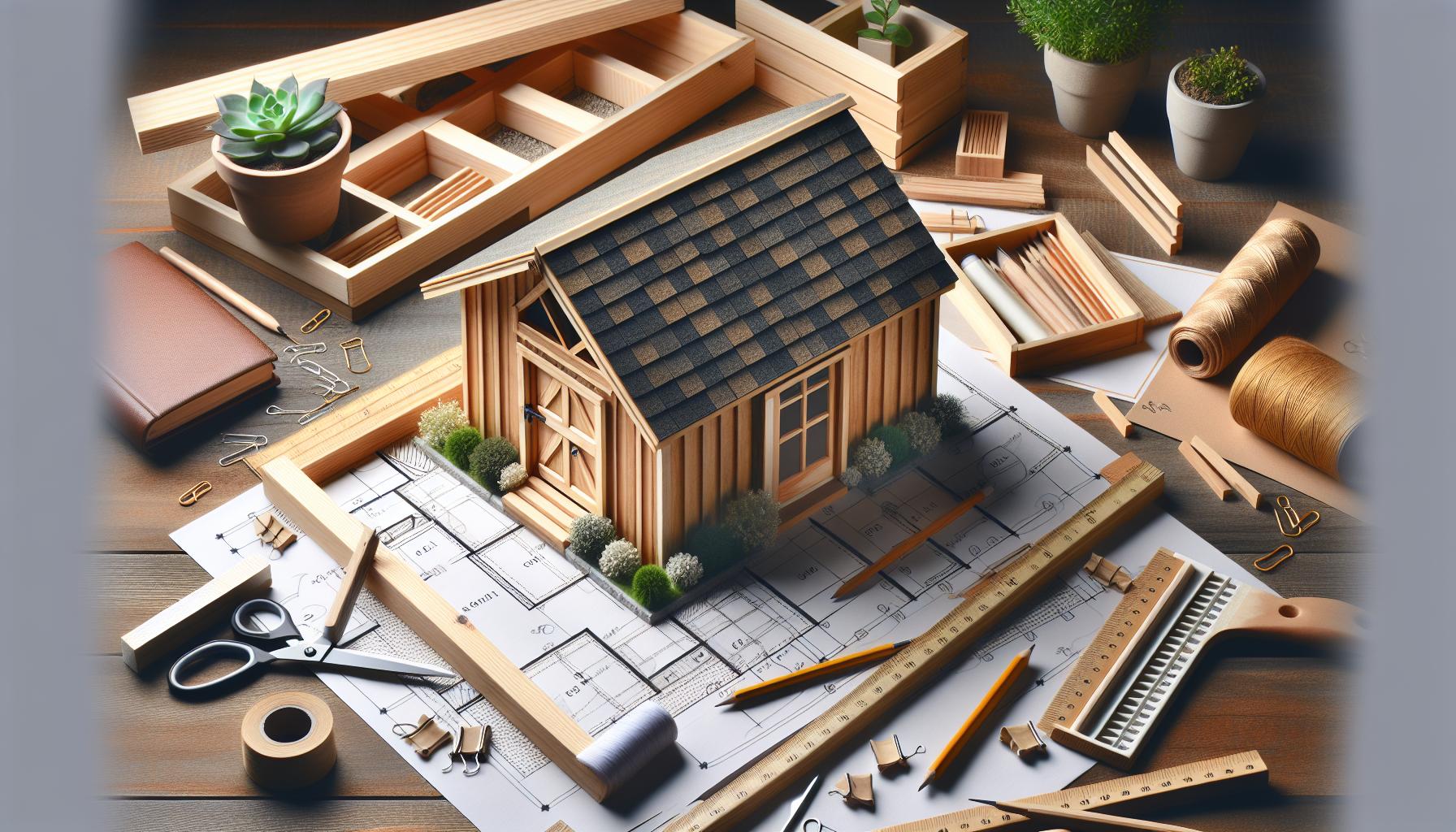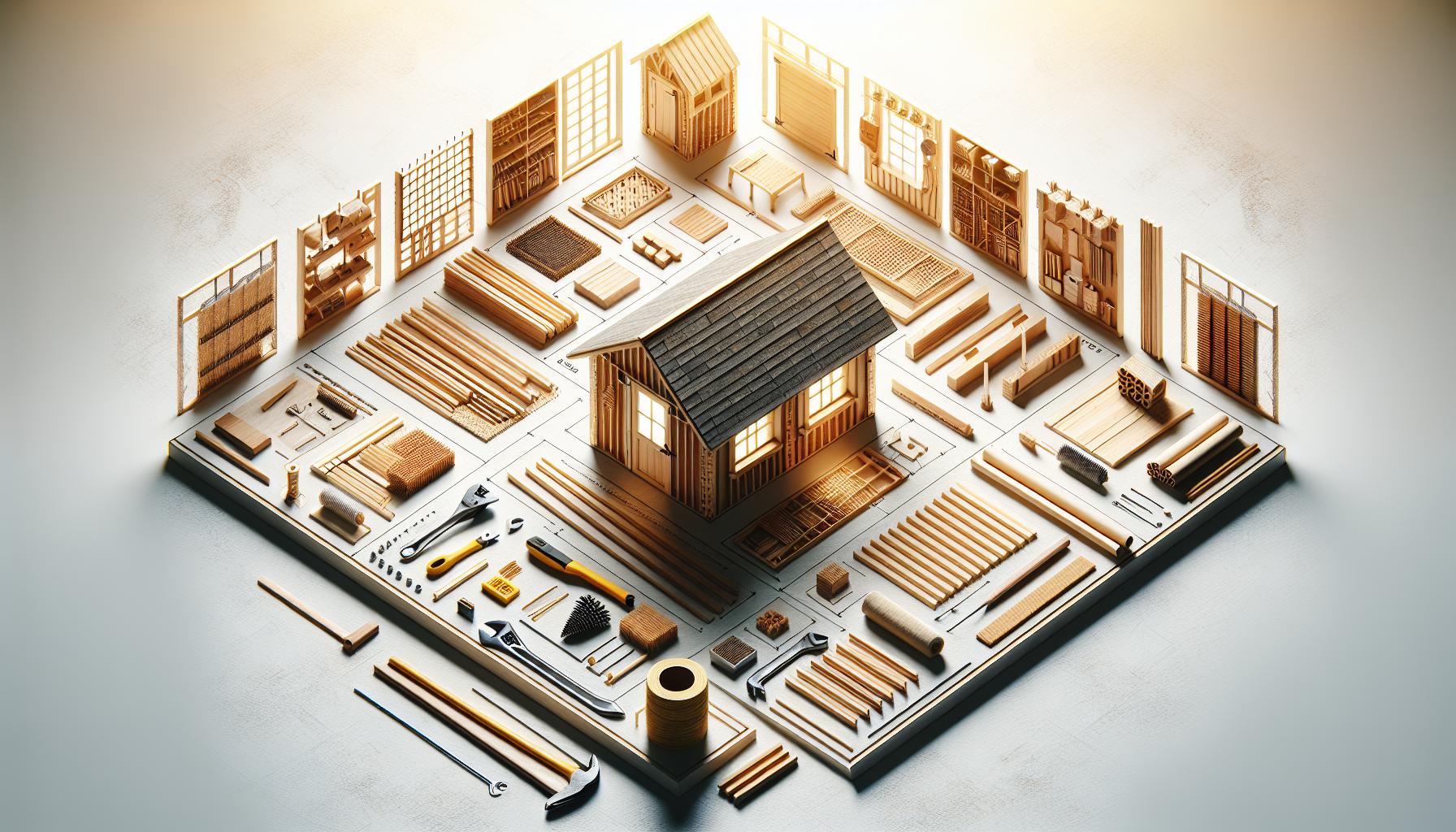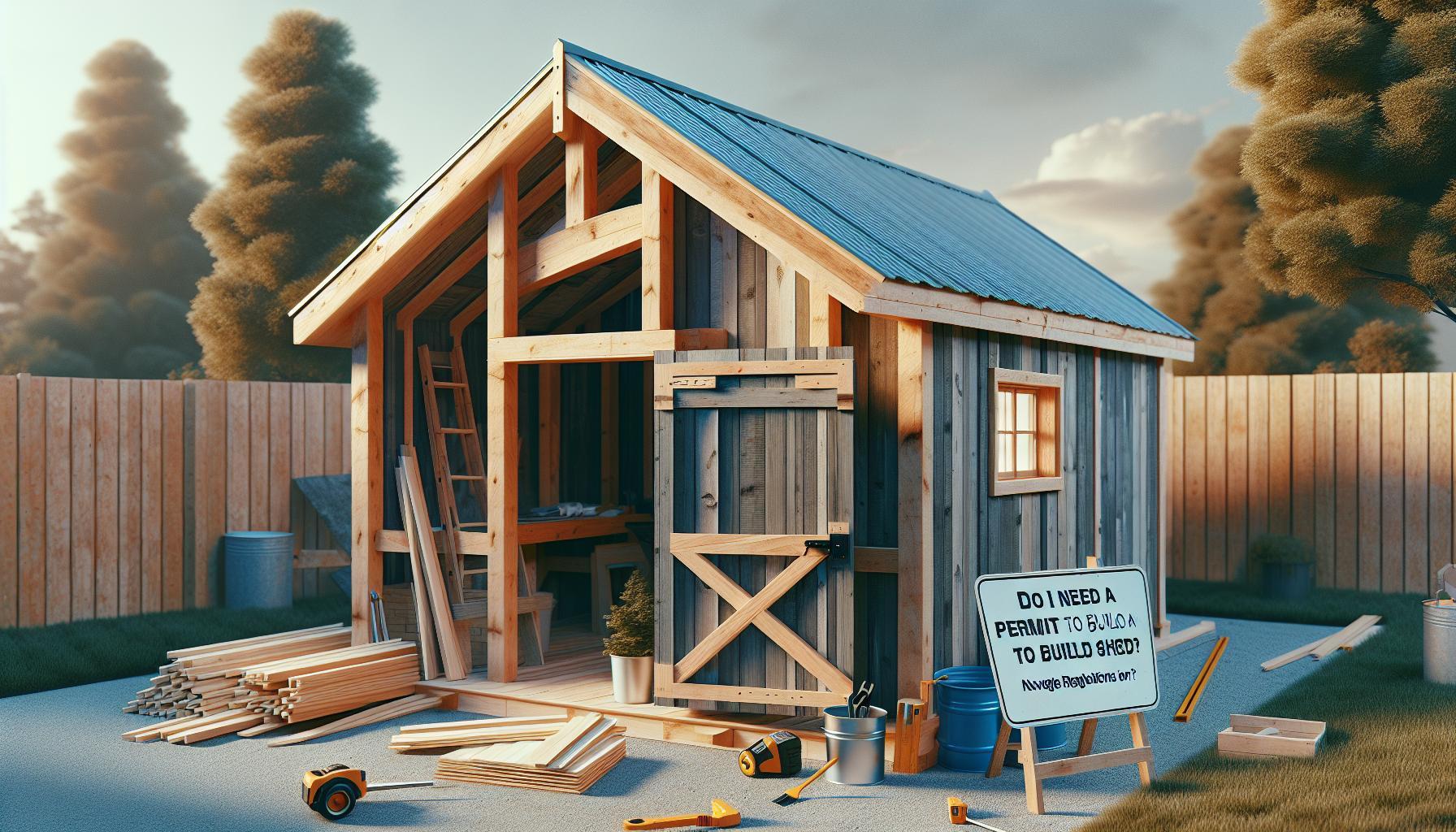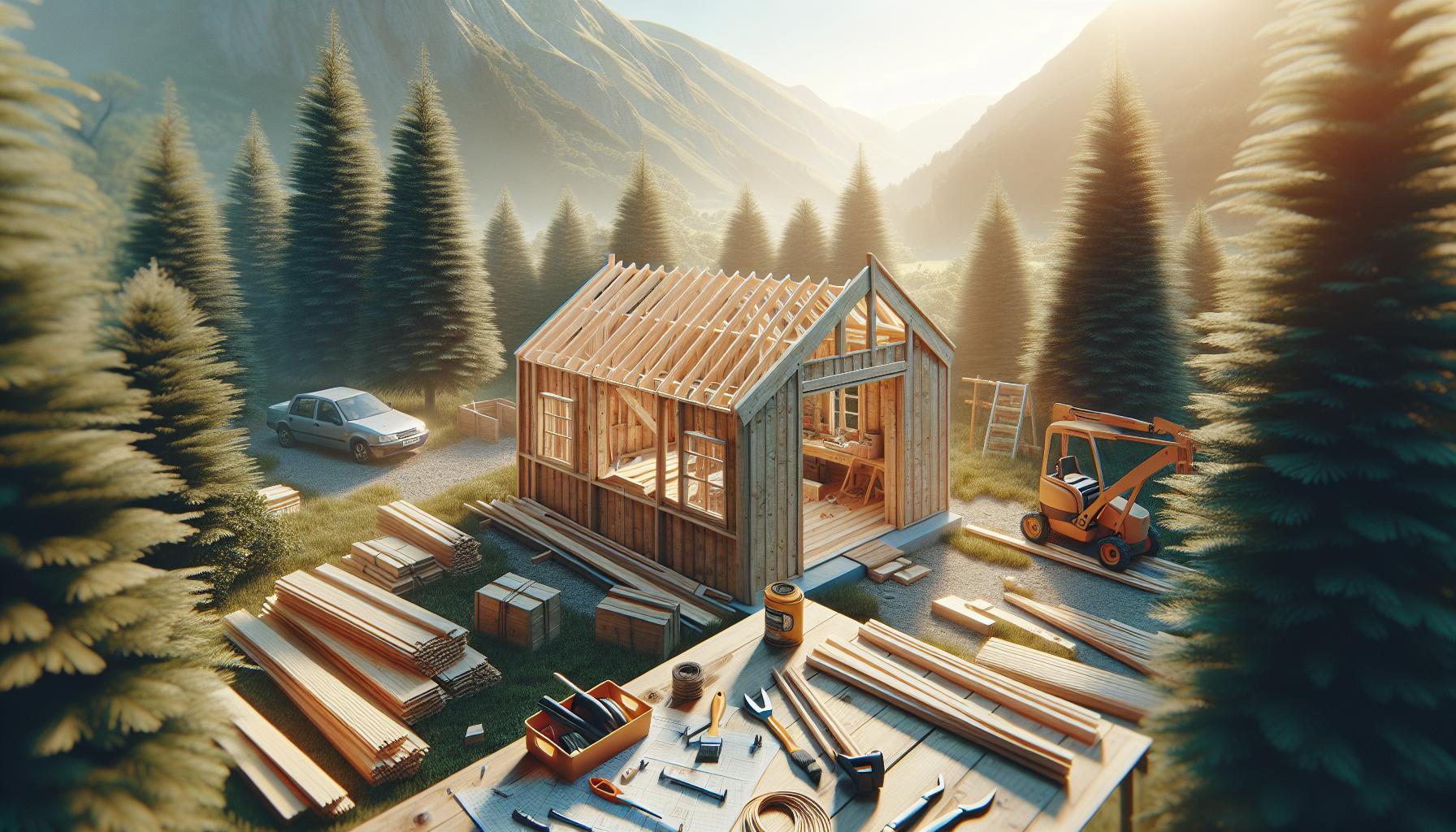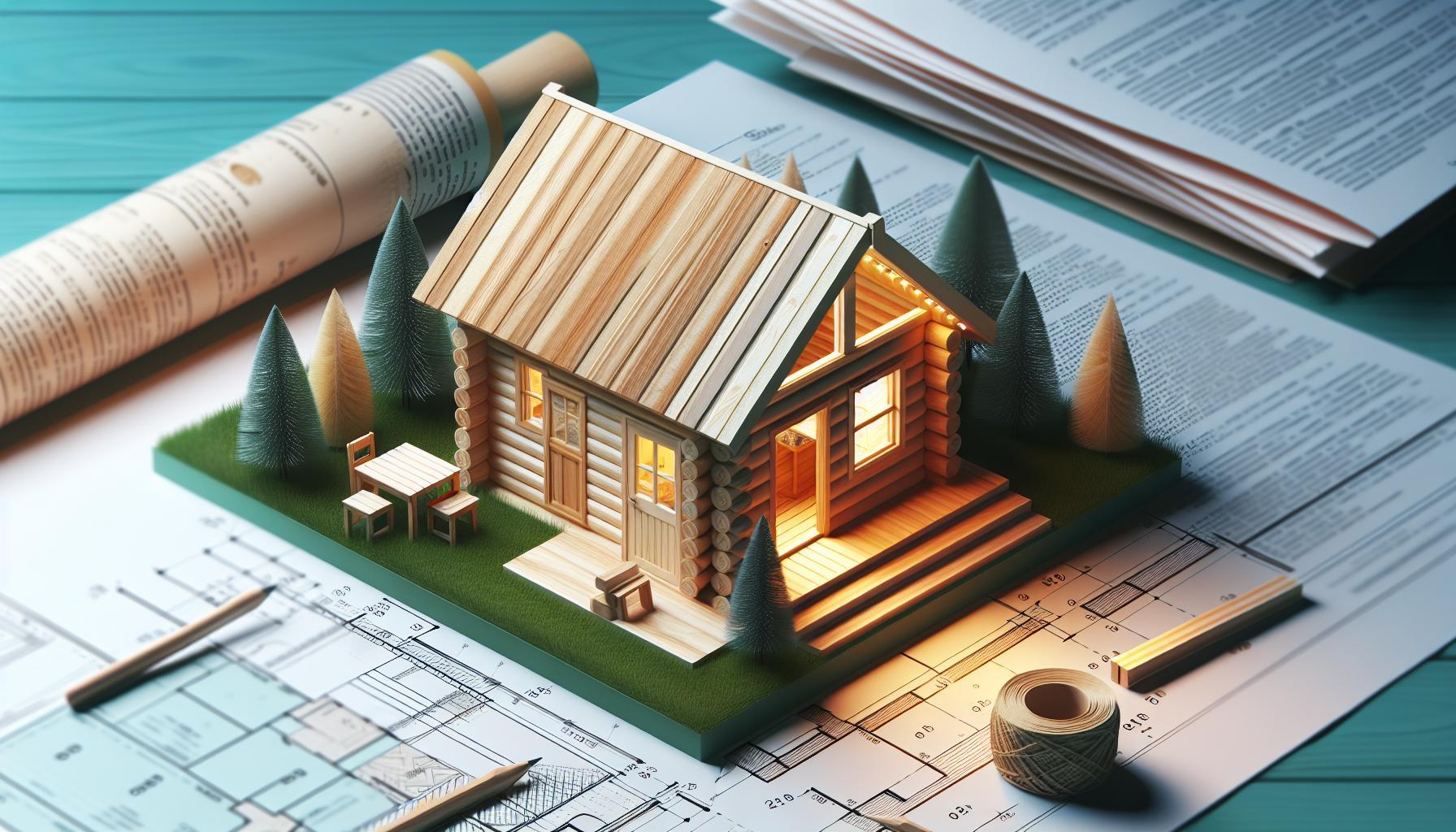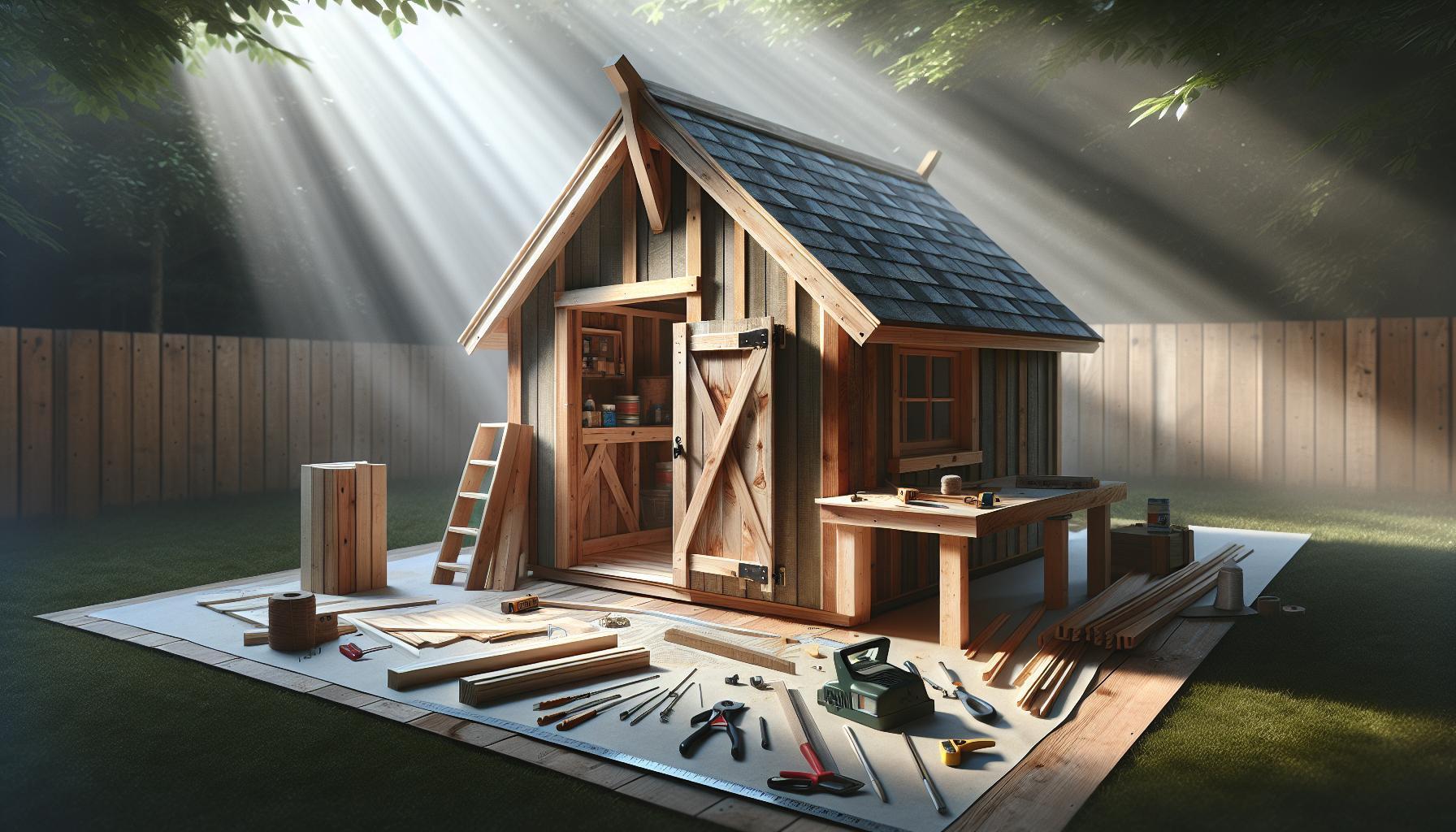Are you planning to build a shed but unsure if you need a permit? Navigating local regulations can be tricky, and understanding the size thresholds for permits is crucial to avoid costly fines. This guide will clarify essential requirements and help you make informed decisions for your outdoor project, ensuring compliance and peace of mind.
Understanding Local Regulations: your First Step Before Building a Shed
Before embarking on your shed-building project, understanding the local regulations that govern construction in your area is crucial. Many homeowners are surprised to learn that even small structures, like garden sheds, can be subject to building permits and specific zoning laws. ignoring these regulations not only risks a hefty fine but can also result in the costly need to dismantle or modify your new shed to meet compliance.The need for a building permit often hinges on the shed’s size and placement.Generally, most municipalities have established size thresholds that dictate when a permit is required. For instance, a common rule is that structures over 100 square feet may necessitate obtaining a permit, but this can vary widely by locality. Always check with your local building department, as they will provide the most accurate and pertinent information regarding your specific situation.
Key Regulations to Consider
Here are some primary factors to explore when determining the need for a permit:
- Setback requirements: Most localities have rules dictating how close a structure can be to property lines. This is essential to ensure sufficient space for maintenance and to uphold neighborhood aesthetics.
- Building height restrictions: Height limits may apply, notably if the shed is close to neighboring structures or in an area with strict zoning laws.
- Permitted uses: Some areas only allow sheds for specific purposes, such as storage or playhouses. Confirming the intended use can prevent any compliance issues.
It’s advisable to consult your local zoning office or building department early in the planning phase. Examine local codes, as some areas may have unique regulations about aesthetics or materials as well. For extensive insight, create a checklist that includes consulting local building codes, determining setbacks, and clarifying whether your shed’s intended use aligns with zoning laws.
Real-World Examples of Compliance Issues
Consider a scenario where a homeowner builds a shed that exceeds the local size limit of 120 square feet without a permit.The local building inspector discovers it during a routine check, leading to a demand for removal or modification. In contrast, a homeowner who diligently adheres to the regulations can enjoy a secure and compliant structure that enhances their outdoor space without unexpected setbacks.
navigating local regulations is a vital first step when planning to build a shed. By understanding and adhering to these guidelines, you can ensure that your shed is built efficiently, safely, and in harmony with local laws.
The Importance of Size: When Does a Shed Require a Permit?
Understanding the nuances of local building regulations can frequently enough feel like navigating a maze. One critical element in this journey is the size of the shed you plan to build. Surprisingly, the dimensions of your outdoor structure can significantly impact whether or not you need a building permit. Local codes and zoning laws frequently stipulate specific size thresholds that determine the necessity of permits. Therefore,before you grab your tools and start construction,it’s imperative to understand the rules that govern your area.
Size Thresholds That Matter
Building permits are usually required for larger structures, which means size is a essential factor when it comes to legal compliance. in many jurisdictions, a common threshold for needing a permit is based on the square footage of the shed. Structures that exceed a certain square footage—often around 120 to 200 square feet—typically must meet regulatory guidelines. Here’s a simplified breakdown of common size thresholds:
| Size of Shed | Typical Permit Requirement |
|---|---|
| Less than 100 sq. ft. | No Permit Required |
| 100 – 200 sq. ft. | Permit Required in Some Areas |
| Over 200 sq. ft. | Permit Required |
consider Local Variations
While the above thresholds provide a general rule of thumb, it’s essential to remember that regulations vary widely by region. Local building departments might have stricter guidelines, so it’s wise to check with your municipality or local building authority. some places may even require permits for smaller structures based on other factors, such as location, intended use, or proximity to property lines.
Real-World examples
To illustrate the importance of these regulations, consider the case of Jane, who wanted to build a small garden shed in her backyard. Initially assuming she didn’t need a permit for her 150-square-foot shed, she proceeded with construction.After a neighbor reported her to local authorities,Jane discovered she needed a permit,which not only resulted in fines but also required her to halt construction until she secured the necessary approvals. This experience underscores the need to verify the specific size guidelines and permit requirements relevant to your project. By investing a little time upfront to understand these regulations, you can save yourself considerable hassle and potential costs down the line.
Navigating Zoning Laws: How They Impact Your Shed plans
Understanding zoning laws is crucial for anyone planning to build a shed, as these regulations dictate where and how structures can be placed on your property. Many homeowners are surprised to find that even something as seemingly innocuous as a shed can be subject to a myriad of local ordinances and restrictions. It is essential to research and comprehend these laws to avoid costly fines or complications down the line.
Why Zoning Laws Matter
Zoning laws are established by local governments to manage land use and ensure that advancement is harmonious within a community.These regulations can dictate aspects such as:
- Setback requirements: The minimum distance a shed must be from property lines.
- Height Restrictions: Limitations on how tall your shed can be.
- Usage Classifications: Guidelines on whether a shed can be used for storage,as a workshop,or for other functions.
As an example, if your property is located in a residential area, local zoning laws may enforce stringent setback requirements, meaning that you might not be able to place your shed as close to the property line as you would like. Conversely, rural areas may have more lenient regulations, allowing for greater adaptability.
Key Steps to Navigate Zoning Regulations
Before drawing up your shed plans, take the following steps to ensure compliance with local zoning laws:
- Check Local Ordinances: Start by checking with your local zoning office or municipal planning department to get a clear understanding of what is permissible in your area.
- Consult the Zoning Map: Frequently enough, cities have zoning maps available online that provide an overview of land use designations in your locality.
- Draft an Accurate Plan: if your shed falls within the size thresholds that require a permit, prepare a detailed plan showing dimensions and intended use, as this may be needed for the approval process.
- Engage with Neighbors: If you anticipate that your shed may impact your neighbors’ views or properties,discussing your plans with them can help facilitate support and minimize objections.
Real-World Zoning Scenarios
To illustrate how zoning laws impact shed planning, consider the following example:
| Scenario | Possible Zoning Impact |
|---|---|
| Building a 12×16 shed in a residential neighborhood | May need a building permit depending on local size thresholds and may require zoning approval. |
| Constructing a 10×8 shed at the edge of your property line | May violate setback requirements for your area and could be subject to penalties. |
| creating a shed for running a home-based business | Can trigger zoning restrictions based on home occupation permits. |
Understanding local zoning laws is crucial before you embark on your shed construction journey. Ignoring these regulations can lead to unwanted surprises that might derail your plans, making it essential to stay informed about the implications related to ‘Do you Need a Building Permit for a Shed? Size Thresholds That Matter.’ Taking the time to navigate through the legal requirements can save you from unnecessary headaches and ensure that your shed is built in accordance with local laws.
Exceptions to the Rule: Permits Not Always Needed
When planning to build a shed, it’s essential to understand that not every installation requires a building permit. In many cases, small structures may fall under specific exemptions that allow homeowners to avoid the sometimes lengthy permitting process. This can be a great relief for those wanting to add extra storage or utility to their property without the hassle. Knowing the parameters can save time,effort,and money.
Generally, the rules surrounding when a shed requires a permit vary by municipality, often depending on factors such as size, height, and location. For instance, many jurisdictions exempt sheds that are below a certain square footage, commonly around 100 to 200 square feet. Additionally,if the shed is below a specific height—generally around 10 to 15 feet—it may also qualify as a non-permitted structure. However, these thresholds can differ widely, so it’s crucial to check local regulations.
Here are some common scenarios where permits are often not needed:
- small Sheds: Structures under 100 square feet typically do not require a permit.
- Temporary Structures: If the shed is intended for temporary use, it usually escapes permit requirements.
- Non-Attached sheds: sheds not affixed to the property may sometimes avoid the permitting process.
- Location Specifics: If the shed is built further from property lines or without utility hookups, it might not need a permit.
While these general guidelines are useful, always verify local codes by consulting your city or county building department. Being proactive about understanding whether you need a permit is critical to ensuring compliance and avoiding penalties. If you find that your planned shed does require a permit, the process can often be expedited for structures intended for practical use, particularly if you follow regional guidelines and regulations. In short, doing your homework not only keeps your project on track but also enhances your overall building experience.
Preparing for the permit process: Tips for DIY enthusiasts
When embarking on the journey of building your own shed, understanding the permit requirements can be both empowering and crucial to the success of your project. If you’re among the many DIY enthusiasts wondering about whether they need to secure a building permit, being prepared can definitely help streamline the process significantly. Familiarizing yourself with local regulations and potential size thresholds can save time,money,and effort,ensuring that your project aligns with municipal guidelines.
Before diving into construction, consider these essential tips for navigating the permit process effectively:
Research Local Regulations
Knowing your local building codes is vital. Different areas have varying rules regarding construction, especially when it comes to size thresholds. Many municipalities require a permit for structures over a certain square footage. Check local government websites or contact the building department directly to clarify what will apply to your shed project.
- Visit your local building department’s website: most provide detailed information on what requires a permit, including specific size thresholds.
- Attend informational sessions: Some municipalities offer workshops or Q&A sessions to help residents understand permitting requirements.
- Consult with local DIY groups: Engage with community forums or social media groups where local builders share their experiences and tips.
Prepare Your Application Thoroughly
Once you’re clear on the requirements, gather all necessary documentation to avoid potential delays in your application process. Essential items typically include:
| Document | Description |
|---|---|
| Site Plan | A detailed drawing showing the shed’s location on your property. |
| Building Plans | Blueprints or sketches of the shed design, including dimensions and materials. |
| Construction Details | Information about the structure, such as the intended use and construction methods. |
| Application Form | A completed form provided by your local building department. |
With these documents in hand, you’ll be better equipped to navigate the application process efficiently. Ensure that all information is accurate to prevent misunderstandings or potential rejections.
Consider Timing and Fees
Understanding the timeline of permit approval will help you plan your project more effectively. Many jurisdictions have varying processing times for approvals that can range from a few days to several weeks. It’s also advisable to factor in any associated fees with the permit application. budgeting for these costs will give you a clearer picture of the overall expenses involved in your shed project.
Be proactive, stay informed, and prepare meticulously to make the permit process for your shed project as smooth as possible. With the right approach, you can transform your DIY vision into reality without unnecessary setbacks.
Common Pitfalls in Shed Construction: What to Avoid
When embarking on the journey of building a shed, many DIY enthusiasts quickly realize that the process isn’t as straightforward as it seems. One of the most critically important missteps involves neglecting the importance of building permits. Failing to secure the necessary permits can lead to costly consequences, including fines or even the need to dismantle your newly constructed shed. Understanding the local regulations associated with “Do You Need a Building Permit for a Shed? Size Thresholds That Matter” is crucial to avoiding these pitfalls.
Ignoring Local Regulations
Each municipality has specific guidelines regarding the construction of sheds, primarily determined by their size. Frequently enough, smaller sheds might not require a permit, while larger structures will. Skipping this initial step can be detrimental. It’s vital to research local building codes to ensure compliance and avoid legal repercussions down the line. This oversight can lead not only to financial penalties but also to wasted effort in building a structure that may ultimately need to be removed.
Underestimating Site Preparation
Another common mistake is failing to adequately prepare the site. Many overlook the foundational aspects necessary for stability and drainage. Improperly prepared sites can lead to water pooling around the shed or shifting ground, potentially compromising the integrity of the build. Ensure that the area is level and well-drained. In certain cases, investing in a proper foundation can save time and money in the long run by preventing issues such as rot or pest infestations.
Misjudging Material Choices
Lastly, selecting inappropriate materials is a frequent pitfall in shed construction. Using lower-quality materials can lead to swift degradation and significant maintenance issues. Always consider the climate and environmental conditions where the shed will be located.For example, if the shed is situated in a humid area, using rot-resistant wood and ensuring proper ventilation is essential to prolong the lifespan of your construction. Choosing quality over cost can make a profound difference in the durability and functionality of your shed.
By avoiding these common pitfalls, you can significantly enhance your shed construction experience. Understanding the nuances of building permits as outlined in “Do You Need a Building Permit for a Shed? Size Thresholds That Matter” not only ensures compliance but also fosters a smoother building process.
Enhancing Your Shed Project: Expert Advice on Design and Compliance
When embarking on a shed construction project, understanding the intersection of design creativity and local regulations is crucial. While the appeal of a custom-built shed can be irresistible, various factors like size, location, and materials significantly influence whether you need a building permit. familiarizing yourself with these requirements can save you from headaches down the line and help to achieve a well-planned,compliant structure.
Understanding Size Thresholds
The first step in your shed project is to grasp the essential size thresholds that trigger the need for a building permit. This aspect varies widely based on jurisdiction,but here are some common benchmarks:
| Jurisdiction Type | Typical Size Threshold | Notes |
|---|---|---|
| Residential | 100-200 sq. ft. | Check local zoning laws |
| agricultural | Varies, often larger | May not require a permit |
| Commercial | Always requires a permit | Subject to strict guidelines |
Understanding how your shed’s dimensions fit into regulation scenarios allows you not only to ensure compliance but also to get creative with your designs. Keep in mind that some jurisdictions might have additional rules regarding sheds positioned within specific distances of property lines or easements.
Design Considerations and Compliance
Incorporating best practices into your design can ensure that your shed meets both functional and aesthetic needs while staying within legal boundaries. Here are actionable steps to consider:
- Choose Appropriate Materials: Materials that align with your local building codes not only enhance durability but can also contribute to your shed’s overall look.
- Plan for Future Needs: Anticipate potential expansions or additional uses for your shed down the line.Planning ahead might save you from needing further permits later.
- Consult Professionals: If unsure about local regulations or design complexities, consider engaging with architects or contractors who are familiar with local permitting processes.
- Research Local Codes: Utilize online resources or visit local authority websites to gather information regarding specific permits you may need.
By taking these steps and remaining informed about the criteria outlined in “Do You need a Building Permit for a Shed? Size Thresholds That Matter,” your shed project can become a seamless blend of personal expression and regulatory compliance. remember, staying well-prepared is the best strategy to ensure your project is successful, legal, and enjoyable.
resources for DIYers: Finding Guidance and Support in Your Area
Understanding the ins and outs of building permits can be a daunting task for anyone looking to embark on a DIY shed project.Fortunately, there are numerous resources available that can provide guidance and support tailored specifically to your needs. Navigating local regulations, especially when considering whether you need a building permit for your shed, doesn’t have to be overwhelming—taking advantage of the right resources can make all the difference.
Local building departments
The first stop for DIYers should be their local building department. These departments are your go-to for information on local zoning laws and regulations related to construction, including the size thresholds that trigger the need for a building permit. Typically, building departments offer:
- Guidelines on local codes and standards
- Resources for specific projects, including set-back requirements
- Permit applications and checklists
- Contact information for building inspectors
visiting your local building department’s website can provide valuable insights and often features downloadable forms that can help expedite your project.
Community Workshops
Many cities and towns host community workshops and seminars aimed at educating homeowners about the DIY process and construction regulations. These events can be an excellent way to get firsthand insights into whether you need a building permit for a shed, including discussing specific size thresholds that matter. Check local libraries, community centers, or home betterment stores for upcoming workshops. Moreover, these gatherings frequently enough encourage interaction with local experts who can answer questions and provide tailored advice based on your situation.
Online Resources and Forums
The digital age offers a wealth of information at your fingertips.websites dedicated to DIY enthusiasts frequently enough have forums where you can discuss specific issues related to building permits with other homeowners or professionals. Some reliable online resources include:
- Home improvement blogs that break down the permitting process
- Government websites that outline regulations by state and municipality
- YouTube channels featuring DIY tutorials, including permitting advice
These platforms can be particularly useful for gaining diverse perspectives on the permitting process and learning from others’ experiences.
Local Nonprofits and cooperative Extensions
In certain regions, local nonprofits or agriculture extension offices may offer assistance to homeowners looking to build. These organizations often focus on lasting building practices and may have programs specifically designed to help you understand when permits are required.They can provide:
- Project planning assistance
- Workshops on sustainable building practices
- one-on-one consultations with building experts
Taking advantage of these community-oriented resources not only connects you with valuable experts but can also foster a sense of community as you embark on your DIY shed project.
Utilizing these resources will empower you to make informed decisions about your shed, ensuring that you adhere to all necessary regulations regarding permits and size thresholds.
Frequently Asked Questions
Do You Need a building Permit for a Shed? Size Thresholds That Matter?
Yes, you typically need a building permit for a shed, but it often depends on the size and location. Many jurisdictions have size thresholds, such as 100 square feet or 200 square feet, below which permits are not required.
It’s essential to check your local building codes and zoning laws since regulations can vary significantly. As an example, a shed larger than 200 square feet might require a full set of plans submitted for approval while smaller ones could only require a simple notification. Always prioritize compliance to avoid costly fines.
What Factors Determine If You Need a Permit for a Shed?
The need for a permit is influenced by factors like size, location, and local regulations. Sheds located closer to property lines often draw scrutiny and may require permits regardless of their size.
Moreover,special conditions like homeowner association rules or environmental considerations might impose additional restrictions. Always research the guidelines specific to your area to ensure you’re not overlooking *critically important requirements* that could impact your project.
Can I build a Shed Without a Permit?
In certain specific cases, you can build a shed without a permit, but this is usually restricted to smaller sizes, frequently enough under 100-200 square feet. Always check your local regulations before proceeding.
Even if you don’t need a permit, it’s wise to consult your local building department or an expert. Being informed can prevent *potential legal problems* down the line, especially if you plan to sell your property in the future.
Why Do Shed Size thresholds Matter for Building Permits?
shed size thresholds matter because they determine whether you need to go through the permit application process, which can be time-consuming and expensive.Smaller sheds are frequently enough judged less strictly as they usually pose less of a risk to neighbors.
The underlying goal of these size thresholds is to ensure safety and proper land use. Such as, larger sheds can significantly affect drainage, property lines, and neighborhood aesthetics, leading municipalities to impose stricter oversight.
What Should I Do if My Shed Exceeds the Size Limit?
If your shed exceeds the size limit set by local regulations, you should apply for a building permit. Gather necessary documentation, and be prepared for inspections or additional requirements.
Consider working with a professional contractor or an architect who can definitely help you navigate the process. They can assist with designing the shed and ensure it meets all code requirements, allowing you to enjoy your investment without future issues. visit our guide on building permits for more details.
What Are the Consequences of Building a shed Without a Permit?
Building a shed without a permit can lead to legal issues, including fines or having to dismantle the shed. Municipalities prioritize compliance with building codes for the safety and integrity of the community.
Not only can you face penalties, but you may also encounter problems when selling your property. Buyers frequently enough conduct due diligence, and unauthorized structures may raise red flags. Always ensure you stay compliant to avoid these *unpleasant outcomes*.
How Can I Check Local Building Codes for My Shed?
You can check local building codes for your shed by visiting your municipal or county website, where you’ll find the relevant zoning and construction regulations. Additionally, local building departments often provide contact details if you have specific questions.
Sometimes, a quick visit to your town hall can yield answers about size thresholds and permit requirements. Don’t hesitate to ask their staff for guidance—they’re there to help you understand the process and ensure your project is legal and safe!
Concluding Remarks
understanding the size thresholds for building permits is crucial when planning your shed project. Remember, regulations can vary significantly depending on your location, so always check with your local authorities before diving in. Whether you’re designing a simple storage shed or a more elaborate workshop, knowing the required permits will save you time, effort, and potential headaches down the line.
As you embark on this journey, celebrate the process of crafting your own space while embracing the learning opportunities that come with it. If you ever find yourself unsure about a particular aspect,don’t hesitate to seek guidance—there’s a wealth of resources available,including local professionals and educated DIY communities. Together, we can navigate the complexities of construction, ensuring your shed not only meets legal standards but also stands as a testament to your creativity and skill.
So, gather your materials, lay out your plans, and let’s transform that vision into reality—your dream shed awaits! happy building!

